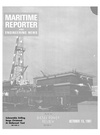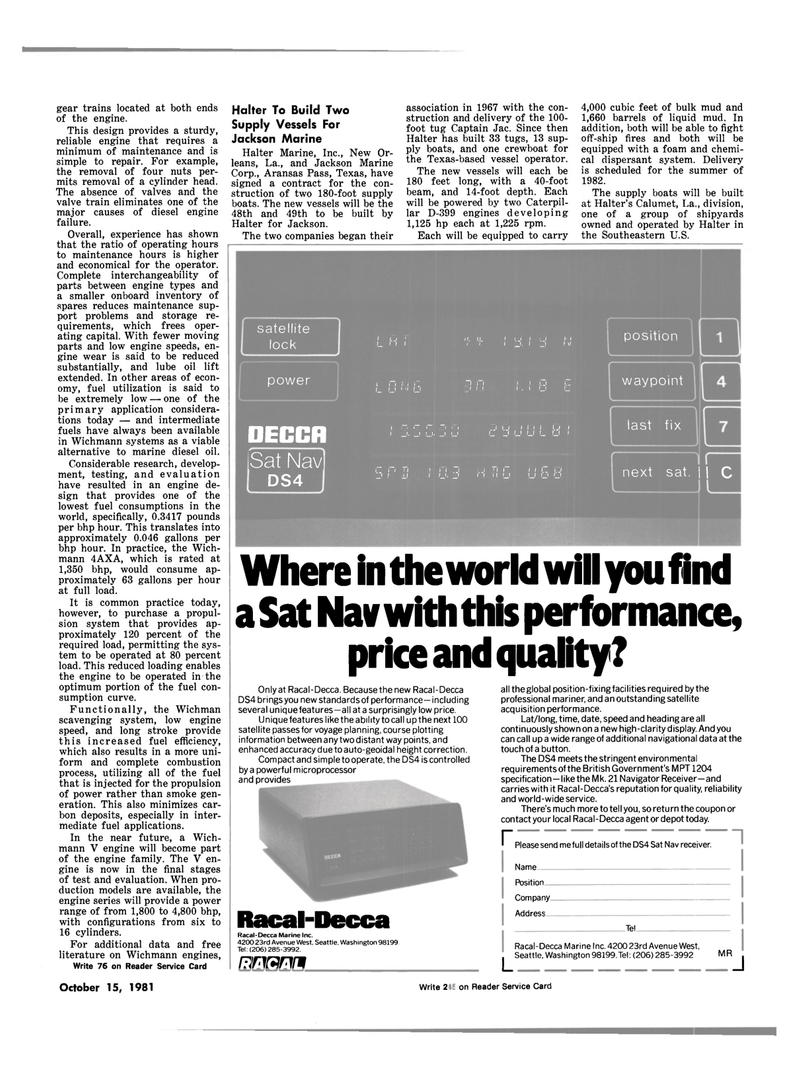
Page 47: of Maritime Reporter Magazine (October 15, 1981)
Read this page in Pdf, Flash or Html5 edition of October 15, 1981 Maritime Reporter Magazine
gear trains located at both ends of the engine.
This design provides a sturdy, reliable engine that requires a minimum of maintenance and is simple to repair. For example, the removal of four nuts per- mits removal of a cylinder head.
The absence of valves and the valve train eliminates one of the major causes of diesel engine failure.
Overall, experience has shown that the ratio of operating hours to maintenance hours is higher and economical for the operator.
Complete interchangeability of parts between engine types and a smaller onboard inventory of spares reduces maintenance sup- port problems and storage re- quirements, which frees oper- ating capital. With fewer moving parts and low engine speeds, en- gine wear is said to be reduced substantially, and lube oil lift extended. In other areas of econ- omy, fuel utilization is said to be extremely low — one of the primary application considera- tions today — and intermediate fuels have always been available in Wichmann systems as a viable alternative to marine diesel oil.
Considerable research, develop- ment, testing, and evaluation have resulted in an engine de- sign that provides one of the lowest fuel consumptions in the world, specifically, 0.3417 pounds per bhp hour. This translates into approximately 0.046 gallons per bhp hour. In practice, the Wich- mann 4AXA, which is rated at 1,350 bhp, would consume ap- proximately 63 gallons per hour at full load.
It is common practice today, however, to purchase a propul- sion system that provides ap- proximately 120 percent of the required load, permitting the sys- tem to be operated at 80 percent load. This reduced loading enables the engine to be operated in the optimum portion of the fuel con- sumption curve.
Functionally, the Wichman scavenging system, low engine speed, and long stroke provide this increased fuel efficiency, which also results in a more uni- form and complete combustion process, utilizing all of the fuel that is injected for the propulsion of power rather than smoke gen- eration. This also minimizes car- bon deposits, especially in inter- mediate fuel applications.
In the near future, a Wich- mann V engine will become part of the engine family. The V en- gine is now in the final stages of test and evaluation. When pro- duction models are available, the engine series will provide a power range of from 1,800 to 4,800 bhp, with configurations from six to 16 cylinders.
For additional data and free literature on Wichmann engines,
Write 76 on Reader Service Card
Halter To Build Two
Supply Vessels For
Jackson Marine
Halter Marine, Inc., New Or- leans, La., and Jackson Marine
Corp., Aransas Pass, Texas, have signed a contract for the con- struction of two 180-foot supply boats. The new vessels will be the 48th and 49th to be built by
Halter for Jackson.
The two companies began their association in 1967 with the con- struction and delivery of the 100- foot tug Captain Jac. Since then
Halter has built 33 tugs, 13 sup- ply boats, and one crewboat for the Texas-based vessel operator.
The new vessels will each be 180 feet long, with a 40-foot beam, and 14-foot depth. Each will be powered by two Caterpil- lar D-399 engines developing 1,125 hp each at 1,225 rpm.
Each will be equipped to carry 4,000 cubic feet of bulk mud and 1,660 barrels of liquid mud. In addition, both will be able to fight off-ship fires and both will be equipped with a foam and chemi- cal dispersant system. Delivery is scheduled for the summer of 1982.
The supply boats will be built at Halter's Calumet, La., division, one of a group of shipyards owned and operated by Halter in the Southeastern U.S. satellite lock power
L H I t n * i i. i u 1" u (I O. I t J I I.J I' I i I I _J. I _J f v' ~in ii Q C I M I.I U !_ position waypoint
DECCH
Sat Nav
DS4 i p l— i~ (ii .J i.J i I i i l.J i i J- 'J • ITi U U L U i r n ti iii o .j T) it i i ci u 13 i jJ ' / «. r ii n u U D CJ last fix next sat. C
Where in the world will you find aSat Nav with this performance, price and quality?
Only at Racal-Decca. Becausethenew Racal-Decca
DS4 brings you new standards of performance— including several unique features —all at a surprisingly low price.
Unique features like the ability to call up the next 100 satellite passes for voyage planning, course plotting information between any two distant way points, and enhanced accuracy due to auto-geoidal height correction.
Compact and simple to operate, the DS4 is controlled by a powerful microprocessor and provides
Racal-Decca
Racal-Decca Marine Inc. 4200 23rd Avenue West. Seattle. Washington 98199.
Tel : (206) 285-3992.
GEEoa all theglobal position-fixing facilities required by the professional mariner, and an outstanding satellite acquisition performance.
Lat/long, time, date, speed and heading are all continuously shown on a new high-clarity display. And you can call up a wide range of additional navigational data at the touch of a button.
The DS4 meets the stringent environmental requirements of the British Government's MPT1204 specification—like the Mk. 21 Navigator Receiver—and carries with it Racal-Decca's reputation for quality, reliability and world-wide service.
There's much more to tell you, so return the coupon or contact your local Racal-Decca agent or depot today. r
Please send me full details of the DS4 Sat Nav receiver.
Name-
Position-
Company^
Address— _Tel_
L
Racal-Decca Marine Inc. 4200 23rd Avenue West,
Seattle, Washington 98199. Tel: (206) 285-3992 MR J
October 15, 1981 Write 3432 on Reader Service Card 49

 46
46

 48
48
